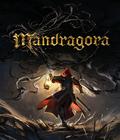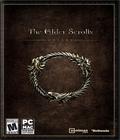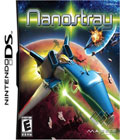Genre: Action
Publisher: Majesco
Developer: Shin'en
Release Date: July 19, 2005
Buy 'NANOSTRAY': NDS
Ship-based overhead shoot 'em ups – affectionately dubbed "shmups" by fans – sit in a strange niche in modern videogaming. They are cheap to develop, yet consistently release at full retail prices in Japan, a practice which goes largely unquestioned within the shmup community. They have extremely basic, sometimes primitive gameplay, yet new releases arrive just about every few weeks, something unheard of for most 2D-based genres. And, strangest of all, these simple games appreciate in value faster than almost any other type of videogame this side of rare Japanese RPGs, with especially sought-after releases like the Saturn classic Radiant Silvergun regularly garnering $200-$300 on the eBay circuit.
Clearly, there is something very special about these games. So special, in fact, that a little German developer by the name of Shin'en has formed for the sole purpose of creating and releasing their take on the genre. So far, their games have been given mixed responses. Iridion, an early Gameboy Advance release, saw lackluster reviews and nearly static sales. Iridion II was met with similar sales, but don't let this fool you; it is one of the best non-Japanese shmups ever made. And now, Shin'en's next release is finally here: Nanostray, a welcome addition to the late-blooming DS lineup.
Nanostray is a bit like Silpheed meets Radiant Silvergun, but don't get all excited just yet; it's a lot more of the former than the latter. 2D gameplay is definitely the bread and butter of Nanostray, but the 3D graphics engine and Silpheed-like camera angle keep the game from touching the same level of quality as your regular Metal Black or Rayforce. Instantly accessible weapons systems are what recall the violent glee of Radiant Silvergun, yet collision issues keep Nanostray from achieving the same classic status as that game – though a cult reputation is still in the cards for the game. This is the first, and hopefully not last shmup for the DS, and while it may be a high quality product worthy of approval from the biggest shmup fan, there's still a lot of improvements left to be made on Shin'en's part.
As with most arcade-style games, Nanostray is meant to be mastered, not just beaten. While some reviewers have bashed the game for its extremely short length, they have forgotten what makes an arcade game fun: practice. Example: Street Fighter II can easily be beaten in 15 minutes. Example: Thunderforce III can be beaten in 20 minutes, no problem. This said, many modern gamers prefer constant environmental changes and have been weaned on playing through most games only once or twice before becoming bored. Those who do not have a self-set bar of achievements readied for the games they play, or who don't have friends to show off their skills to, might not need apply for Nanostray.
The main single-player mode is set up in a halfway non-linear fashion. Similar to Starfox, players can choose one of a selection of stages on a similar tier of difficulty. Unlike that game, a single path is not meant to be taken through the game. Nanostray, being quite a bit more thin on story, allows players to poke every single mission icon on the touch screen before moving up to the next tier of difficulty.
On the default easy mode, Nanostray might seem like a joke to most shmuppers. Players are given five lives and copious use of the limited secondary firing mechanisms for the four main weapons systems in the game. Enemies will be wiped off the screen long before becoming anywhere near a threat to the player in all but the most chaotic sections in each stage – but that's the easy mode.
In every other difficulty setting, the game is quite a bit more of a challenge. Finally, full use of each type of weapon is required – which is, strangely, where much of the trouble with Nanostray comes in. The four different weapon types can be switched between freely, but only through extremely clunky use of the touch screen. Four touch icons representing each weapon line the right side of the screen, requiring the player to move their thumb off the face buttons and onto the screen for a split second. That may sound simple enough, but there are dangers inherent to shmups that cause some problems with this control method.
Due to the "twitch" gameplay that is the most significant feature of shmups, even a moment away from the controls can mean death. This is somewhat remedied by an awkward but functional solution: The L button can also be used as a firing button, which works fine but feels unnecessary, forcing face button inclined players to perform a seesaw motion from the face buttons to the L button. This also completely removes the secondary firing function from the players access until the weapon has been switched. The other, larger problem is one that can be solved with experience – the issue of diverting one's eyes from the top screen in order to glance at the bottom screen to see which weapon is being chosen. After a few hours of play, looking down at the icons is not as urgent, but the learning curve needed to avoid diverting one's eyes is a bit deep, given how unintuitive it would be for those used to more standard shmup fare.
Some players will remedy the above issues by sticking with the default forward spread shot for the entirety of the game. With some practice, this can work, but as for meeting any of the goals set by the 22-mission challenge mode – point challenges, specific mission limitations – every weapon in the arsenal will have a number of specific uses. The forward spread will be used most often, of course, but enemy layouts often make the side shot a necessity. The latter two shots, both of which seek out enemies, are best used on bosses. The twin lasers are best used for far off enemies, especially with the locking energy burst secondary fire, and the Raiden-ripoff electro-wave is good for overwhelming waves of enemies or especially hyperactive bosses, which can be promptly damaged by the secondary electric storm attack, which surrounds the ship and spreads outward from all sides.
If it is not obvious already, Shin'en clearly put a great deal of thought into most aspects of Nanostray. Keyword: most.
The graphical style choices are among the biggest problems with the game, yet also the biggest draw. Upon first glance, Nanostray is a beautiful game on the DS screens. Except for a few rare moments, the game has a smooth post-64-bit sheen, with bright textures, smooth animation (slowdown is extremely rare, which is a rare feat in itself for a shmup), great lighting effects, and good use of sprites on the bottom screen, even if the radar screen is a bit useless. The problem is when all of this becomes intertwined with the gameplay.
During gameplay, the camera sits in a strange angled overhead position that causes problems not normally present in polygonal shmups. Most other 3D shmups retain the 2D gameplay to the fullest, such as Treasure's modern classic Ikaruga, by keeping the camera in a full overhead position. Nanostray, in emulating the vastly inferior (though visually impressive) presentation of Silpheed as opposed to Chaos Field, Ikaruga, Raiden V, and many others, is thus left an inferior game. As pretty as Nanostray is, the collision problems caused by this strange angle are unforgivable when applied to the delicate balance of a shmup. It is, in my very humble opinion, the best-looking 3D title on the DS so far, but because of this design choice, many, many unnecessarily frustrating moments have ensued during my time with the game.
Like the graphics, the sonic presentation also stands up mightily, though without any problems with connected with the gameplay. The soundtrack many not inspire me to charge out the door and pick up the OST, but it is the right kind of "videogame" music that every shmup needs to have – that is to say, not exactly electronic dance music, not exactly an approximation of rock or orchestral music, but that increasingly rare form of music that makes any listener, from any generation, think, "this is a videogame song." Of course, the sound samples follow suit with this, never approaching cheesiness yet also never brushing elbows with realism, retaining the wonderful "zap" and "blam" quality that so many games have been ignoring as of late. Nanostray is always straight-faced but seems refreshingly innocent in the face of the current string of "Street Games" that have overrun the market.
If not for issues with the touch screen, and especially the simple yet deep problems set off by Shin'en's camera angle choice, I might have gone as far as to write my letter of recommendation for Nanostray to sit in non-Japanese shmup classic status, along with Amiga greats like Apidya. Sadly, the game is too flawed for me to consider it being anything more than a preferred cult title. It's a beautiful game to look at and a blast to play, but most shmup fans will be frustrated by the glaring flaws it carries. Still, for the DS owner in need of a fun new game, Nanostray is the best choice outside of Kirby's Canvas Curse. So, if you're even remotely interested in shmups, give Shin'en your support – if you can find the game, that is, given its sadly limited release.
Score: 6.9/10
More articles about Nanostray










 A 3D sci-fi shooter developed by Shinen, Nanostray boasts a wide array of weapons, un-lockable features and game modes, as well as an online ranking system that tracks the games top players. Nanostrays touch screen features will allow players to track enemy movement via interactive radar and manage the various weapons and other special pick ups.
A 3D sci-fi shooter developed by Shinen, Nanostray boasts a wide array of weapons, un-lockable features and game modes, as well as an online ranking system that tracks the games top players. Nanostrays touch screen features will allow players to track enemy movement via interactive radar and manage the various weapons and other special pick ups.















































